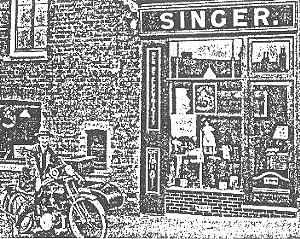Sidecar Salesman
Graham Forsdyke
ISMACS News
Issue No. 35
April 1992

ONE VEHICLE which has all-but disappeared from the roads is the motor-cycle sidecar.
It's not surprising, for although I earned a living of sorts for a time racing them, a motor-cycle combination is a complete anachronism. On the road it combined all the disadvantages of the car (width, parking, etc) with all the discomfort of a motor cycle.
The sidecar enjoyed a heyday in the 1920s to 1950s simply because it could be ridden on a motor-cycle license, tax was cheap, and the things were usually so underpowered and over- weight performance was such that they enjoyed the cheapest insurance on the road.
The advent of the Reliant three-wheeler with similar advantages sounded the death knell of the double-adult combination and eventually more affluent times made car ownership common place.
But it wasn't the case in the 1920s when motor-cycle combinations came into their own in the sewing-machine trade.
A sidecar was just the right size for transporting a sewing machine.
One salesman made his case in the Singer magazine Red S in 1924 thus:
"With even a light sidecar one may go off to outlying places with a machine ready for demonstration, a bagfull of smalls and a supply of pamphlets.
"One arrives fresh and invigorated and ready for the fray which is not always the case with the man on foot.
"Practically every village one passes possesses its own small garage where the whole outfit can be safely stowed away for an hour or so for sixpence which invariably returns to one's own pocket with the sale of the first few smalls."
Our enthusiast also found out that being able to deliver machines instantly pays off.
If he tells a customer he will get the machine delivered by a cartman in the next days there was a great possibility of the client talking it over at home with hubby and canceling the sale. With the sidecar the machine could be installed and signed for by the time the breadwinner got home from work.
The writer's motor cycle was a 3.5hp Warrier powered by a two-stroke Villiers engine with purpose-built sidecar which doubled as delivery vehicle and by the addition of a seat, family transport at the weekends.
He estimated running costs for his 100 miles per week at 4s 6d (22.5p) for 1.5 gallons of petrol and oil
That two shillings should, of course, have been put away each week for replacement parts etc, but our enthusiast admitted that he didn't.
"I rely on a good week's sales for when the outfit needs new tyres", he admitted.





